Golimumab: A human anti-TNF-alpha monoclonal antibody for the treatment of autoimmune joint diseases
Golimumab is a human anti-tumor necrosis factor (TNF)-alpha monoclonal antibody that was recently approved for the treatment of rheumatoid arthritis, psoriatic arthritis, and ankylosing spondylitis.

Key Points
Abstract
Golimumab is a human anti-tumor necrosis factor (TNF)-alpha monoclonal antibody that was recently approved for the treatment of rheumatoid arthritis (RA), psoriatic arthritis (PsA), and ankylosing spondylitis (AS). In clinical trials, subcutaneous (SC) golimumab injected every 4 weeks significantly improved clinically relevant end points in all 3 disease states. In patients with RA, golimumab is approved for use in combination with methotrexate (MTX); in patients with PsA or AS, golimumab may be used with or without MTX. Golimumab may increase the risk for upper respiratory tract infection, lymphoma, and injection-site reaction, but the incidence of these adverse events was low in clinical trials. (Formulary . 2009;44:264–272.)
Rheumatoid arthritis (RA) is an immune-mediated inflammatory disease of the joints. Patients with RA typically present with pain, stiffness, and swelling of the joints that may eventually lead to joint damage and erosion of the bone.1 Disease-modifying antirheumatic drugs (DMARDs) should be initiated within 3 months of diagnosis to combat the progression of RA.1 Nonsteroidal anti-inflammatory drugs (NSAIDs) and corticosteroids are useful for symptomatic relief, although neither class of drugs affects disease progression.2 Methotrexate (MTX) is the most commonly used DMARD and functions by inhibiting dihydrofolate reductase and blocking the synthesis of purine and pyrimidine nucleotides.2 In cases where symptoms persist despite MTX therapy, biologic agents that target tumor necrosis factor-alpha (TNF-alpha) may be added to the treatment regimen.2
Ankylosing spondylitis (AS), another inflammatory joint condition, involves chronic inflammation of joints such as the sacroiliac, axial skeleton, entheses, and peripheral joints, and typically has an onset of late adolescence or early adulthood.4 Increased inflammation of the joints may lead to new bone formation and ankylosis of joints, which restricts patients' mobility.5 NSAIDs are first-line therapy in AS, with analgesics considered for pain control if NSAIDs are insufficient.4 Intra-articular corticosteroids may also be used, but there is little evidence to support the use of systemic corticosteroids.4 Unlike RA and PsA, there is little evidence to support the use of DMARDs in axial disease, although sulfasalazine may be considered in patients with peripheral arthritis.4 In cases with persistent disease activity despite conventional therapies, anti-TNF agents may be considered.4
Although they are unique conditions, these autoimmune joint diseases share many clinical features and treatment strategies, which has led to the development of agents that target common pathways among the diseases. Because TNF-alpha levels are elevated in the blood, synovium, and joints of patients with RA, PsA, and AS, TNF-alpha has become a target of drug therapy. Currently available anti-TNF agents include infliximab, adalimumab, etanercept, and certolizumab.6–9 In April 2009, FDA approved a new anti-TNF agent, golimumab (Simponi, Centocor), for the treatment of RA, PsA, and AS.10,11
CHEMISTRY AND PHARMACOLOGY
Golimumab is a human immunoglobulin (Ig) G1-kappa monoclonal antibody (mAb) that is specific for TNF-alpha. Golimumab binds to both the soluble and transmembrane forms of human TNF-alpha, which is an inflammatory mediator, and thereby inhibits its destructive biological activity.10
PHARMACOKINETICS
Golimumab appears to exhibit dose-dependent pharmacokinetics with both intravenous (IV) and subcutaneous (SC) administration; steady-state concentration is reached within 12 weeks.10,12,13 With SC administration, the time to reach maximum serum concentration (2.5 mcg/mL) in healthy participants ranges from 2 to 6 days.10 Concomitant use of MTX results in a mean steady-state trough serum concentration of 0.4 to 0.6 mcg/mL, 0.5 mcg/mL, and 0.8 mcg/mL in patients with RA, PsA, and AS, respectively.10 Patients with RA, PsA, and AS who were treated with golimumab and MTX had approximately 52%, 36%, and 21% higher mean steady-state trough concentrations compared with those treated without concomitant MTX, suggesting a potential drug interaction between these 2 agents.10
CLINICAL TRIALS
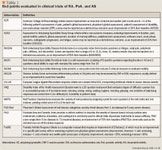
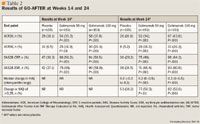

The Golimumab for Subjects With Active RA Despite Methotrexate (GO-FORWARD) study was a phase 3, randomized, double-blind, placebo-controlled trial evaluating the efficacy and safety of golimumab in patients with active RA (N=444) despite stable MTX therapy in doses between 15 and 25 mg/wk for ≥4 weeks before study entry.21 During the study, patients were allowed to continue stable doses of NSAIDs or corticosteroids, but previous use of anti-TNF agents, rituximab, natalizumab, or cytotoxic agents was prohibited. Patients were randomized to 1 of 4 treatment groups, in which SC injections were administered every 4 weeks and capsules were taken orally every week: 1) placebo injections plus MTX capsules; 2) golimumab 100-mg injections plus placebo capsules; 3) golimumab 50-mg injections plus MTX capsules; or 4) golimumab 100-mg injections plus MTX capsules. All patients except those in the second group continued their stable doses of MTX. At Week 16, patients who experienced inadequate response entered early escape therapy, in which dose-escalation occurred. Patients in the first group switched from placebo injections to golimumab 50 mg; patients in the second group switched from placebo capsules to their previously stable MTX dose; patients in the third group switched from golimumab 50 mg to 100 mg; and patients in the fourth group had no dosage adjustments made. All other treatments were continued as assigned. The primary end points of the trial were ACR20 response and change in HAQ scores.

Psoriatic arthritis. Golimumab: A Randomized Evaluation of Safety and Efficacy in Subjects with Psoriatic Arthritis Using a Human Anti-TNF Monoclonal Antibody (GO-REVEAL) was a phase 3, randomized, double-blind, placebo-controlled trial.13 Enrolled patients (N=405) had active PsA, defined as the presence of ≥3 swollen and 3 tender joints and presence of plaque psoriasis, despite therapy with DMARDs or NSAIDs. Participants were allowed to continue stable doses of MTX, NSAIDs, and corticosteroids during the study, but patients were excluded if they had previously used anti-TNF agents, rituximab, natalizumab, or cytotoxic agents. Patients were stratified by baseline MTX use and then randomized to SC injections of placebo, golimumab 50 mg, or golimumab 100 mg every 4 weeks. Those who did not have an adequate response to therapy at Week 16 entered early escape therapy, in which patients taking placebo switched to golimumab 50 mg, patients taking golimumab 50 mg switched to golimumab 100 mg, and patients taking golimumab 100 mg continued therapy with blinded golimumab 100 mg. The primary end point was an ACR20 response.
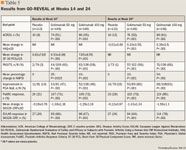
Ankylosing spondylitis. Golimumab: A Randomized Study in Ankylosing Spondylitis Subjects of a Novel Anti-TNF mAb Injection (SC) Given Every Four Weeks (GO-RAISE) was a phase 3, randomized, double-blind, placebo-controlled trial evaluating the safety and efficacy of golimumab in patients with active AS (N=356) as defined by the modified New York Criteria (which evaluates limitation of lumbar spine movement, pain, and limitation of chest expansion) for ≥3 months, a BASDAI score of ≥4, and a spinal back pain score of ≥4 on a visual analog scale (VAS) (range, 0–10) despite current or previous NSAID or DMARD therapy.5 Patients who had been previously treated with anti-TNF agents or who had complete ankylosis of the spine were excluded. Patients were allowed to continue stable doses of MTX, sulfasalazine, hydroxychloroquine, corticosteroids, or NSAIDs during the study. Patients were stratified by C-reactive protein (CRP) levels and then randomized to treatment with SC injections of placebo, golimumab 50 mg, or golimumab 100 mg every 4 weeks. Patients with inadequate response at Week 16 entered early escape therapy, in which doses were escalated in the same fashion as in the GO-REVEAL study. The primary end point was the proportion of patients achieving ASAS20.
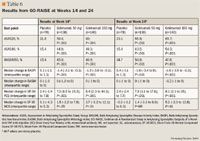
ADVERSE EVENTS
The combined rate of serious infection in all patients enrolled in phase 3 trials was 1.4%, with 1.4% of golimumab-treated patients and 1.3% of placebo-treated patients experiencing a serious infection.10 Serious infections included sepsis, pneumonia, cellulitis, abscess, tuberculosis, invasive fungal infection, and hepatitis B. The incidence of active tuberculosis in phase 2 and 3 trials was 0.23 and 0 per 100 patient-years in 2,347 golimumab-treated patients and 674 placebo-treated patients, respectively.10 Malignancy is another concern with the use of anti-TNF agents. Higher rates of lymphoma per 100 person-years occurred in golimumab-treated patients (0.21; 95% CI, 0.03–0.77) than in placebo-treated patients (0; 95% CI, 0–0.96) throughout phase 2 and phase 3 trials.10 However, there was no difference between the 2 groups in the incidence of nonlymphoma malignancy.10 Injection-site reactions occurred in 6% of golimumab-treated patients compared with 2% of placebo-treated patients, but symptoms (usually erythema at injection site) were mild.10 Elevations in liver transaminases were observed in clinical trials, but there was no significant difference in incidence between the groups. No contraindications are listed in product labeling for golimumab.10 At this time, 52-week data have not been published; studies with duration of up to 5 years are ongoing.
DRUG INTERACTIONS
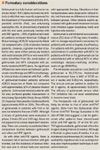
DOSING AND ADMINISTRATION
Golimumab is available as a single-use prefilled syringe or autoinjector (a device designed to mechanically deliver a single dose of medication on initiation) providing 50 mg per 0.5 mL of solution. The drug must be refrigerated and protected from light inside its carton until the time of use. Thirty minutes before injection, the prefilled syringe or autoinjector must be removed from the carton and allowed to sit at room temperature to warm the solution. Golimumab should not be warmed in any other manner. The solution should be visually inspected before injection and should be clear or slightly opalescent and colorless to light yellow. If the solution is cloudy or discolored or if visual particles are present, the solution should not be used.10
Golimumab is approved for use as a single SC 50-mg dose every 4 weeks. Injection sites should be rotated and injections avoided in areas where skin is tender, bruised, red, or hard. For patients with RA, golimumab should be administered in combination with MTX; for patients with PsA or AS, golimumab can be used with or without MTX or other nonbiologic DMARDs. No dosage adjustments are necessary for patients with renal or hepatic insufficiency.10
In each issue, the "Focus on" feature reviews a newly approved or investigational drug of interest to pharmacy and therapeutics committee members. The column is coordinated by Robert A. Quercia, MS, RPh, clinical manager and director of Drug Information, Department of Pharmacy Services, Hartford Hospital, Hartford, Conn, and adjunct associate professor, University of Connecticut School of Pharmacy, Storrs, Conn; and by Craig I. Coleman, PharmD, assistant professor of pharmacy practice, University of Connecticut School of Pharmacy, and director, Pharmacoeconomics and Outcomes Studies Group, Hartford Hospital.
EDITORS' NOTE: The clinical information provided in "Focus on" articles is as current as possible. Due to regularly emerging data on developmental or newly approved drug therapies, articles include information published or presented and available to the author up until the time of the manuscript submission.
Dr Phung is an outcomes research fellow, University of Connecticut/Hartford Hospital Evidence-Based Practice Center. Dr Coleman is an associate professor of pharmacy practice, University of Connecticut School of Pharmacy, and methods chief and program director, University of Connecticut/Hartford Hospital Evidence-Based Practice Center.
Disclosure Information: The authors report no financial disclosures as related to products discussed in this article.
REFERENCES
1. O'Dell JR. Therapeutic strategies for rheumatoid arthritis. N Engl J Med. 2004;350:2591–2602.
2. Hutas G. Golimumab, a fully human monoclonal antibody against TNFalpha. Curr Opin Mol Ther. 2008;10:393–406.
3. Gottlieb A, Korman NJ, Gordon KB, et al. Guidelines of care for the management of psoriasis and psoriatic arthritis: Section 2. Psoriatic arthritis: Overview and guidelines of care for treatment with an emphasis on biologics. J Am Acad Dermatol. 2008;58:851–864.
4. Zochling J, van der Heijde D, Burgos-Vargas R, et al; Assessment in AS international working group; European League Against Rheumatism. ASAS/EULAR recommendations for the management of ankylosing spondylitis. Ann RheumDis. 2006;65:442–452.
5. Inman RD, Davis JC Jr, Heijde D, et al. Efficacy and safety of golimumab in patients with ankylosing spondylitis: Results of a randomized, double-blind, placebo-controlled, phase III trial. Arthritis Rheum. 2008;58:3402–3412.
6. Humira [package insert]. Chicago, IL: Abbott; 2009.
7. Enbrel [package insert]. Thousand Oaks, CA: Amgen/Wyeth; 2009.
8. Remicade [package insert]. Malvern, PA: Centocor Inc; 2009.
9. Cimzia [package insert]. Smyrna, GA: UCB, Inc; 2009.
10. Simponi [package insert]. Horsham, PA: Centocor Ortho Biotech; 2009.
11. Simponi (golimumab) receives FDA approval as first once-monthly anti-TNF for treatment of rheumatoid arthritis, psoriatic arthritis and ankylosing spondylitis [press release]. Horsham, PA: Centocor Ortho Biotech; April 24, 2009.
12. Zhou H, Jang H, Fleischmann RM, et al. Pharmacokinetics and safety of golimumab, a fully human anti-TNF-alpha monoclonal antibody, in subjects with rheumatoid arthritis. J Clin Pharmacol. 2007;47:383–396.
13. Kavanaugh A, McInnes I, Mease P, et al. Golimumab, a new human tumor necrosis factor alpha antibody administered every four weeks as a subcutaneous injection in psoriatic arthritis: Twenty-four-week efficacy and safety results of a randomized, placebo-controlled study. Arthritis Rheum. 2009;60:976–986.
14. Mease PJ, Antoni CE, Gladman DD, Taylor WJ. Psoriatic arthritis assessment tools in clinical trials. Ann Rheum Dis. 2005;64(suppl 2):ii49–54.
15. Gladman DD, Helliwell P, Mease PJ, Nash P, Ritchlin C, Taylor W. Assessment of patients with psoriatic arthritis: A review of currently available measures. Arthritis Rheum. 2004;50:24–35.
16. Rich P, Scher RK. Nail Psoriasis Severity Index: A useful tool for evaluation of nail psoriasis. J Am Acad Dermatol. 2003;49:206–212.
17. Menter A, Gottlieb A, Feldman SR, et al. Guidelines of care for the management of psoriasis and psoriatic arthritis: Section 1. Overview of psoriasis and guidelines of care for the treatment of psoriasis with biologics. J Am Acad Dermatol. 2008;58:826–850.
18. Clegg DO, Reda DJ, Mejias E, et al. Comparison of sulfasalazine and placebo in the treatment of psoriatic arthritis. A Department of Veterans Affairs Cooperative Study. Arthritis Rheum. 1996;39:2013–2020.
19. Smolen JS, Kay J, Doyle MK, Landewe R, et al; GO-AFTER study investigators. Golimumab in patients with active rheumatoid arthritis after treatment with tumour necrosis factor alpha inhibitors (GO-AFTER study): A multicentre, randomised, double-blind, placebo-controlled, phase III trial. Lancet. 2009;374:210–221.
20. Emery P, Fleischmann RM, Moreland LW, et al. Golimumab, a human anti-tumor necrosis factor alpha monoclonal antibody, injected subcutaneously every four weeks in methotrexate-naive patients with active rheumatoid arthritis: Twenty-four-week results of a phase III, multicenter, randomized, double-blind, placebo-controlled study of golimumab before methotrexate as first-line therapy for early-onset rheumatoid arthritis. Arthritis Rheum. 2009;60:2272–2283.
21. Keystone EC, Genovese MC, Klareskog L, et al; GO-FORWARD Study. Golimumab, a human antibody to tumour necrosis factor alpha given by monthly subcutaneous injections, in active rheumatoid arthritis despite methotrexate therapy: The GO-FORWARD study. Ann Rheum Dis. 2009;68:789–796.
22. McInnes I, Kavanaugh A, Kreuger GG, et al. Golimumab, a new human TNF-alpha antibody, administered every 4 weeks as a subcutaneous injection in psoriatic arthritis: Response to pneumococcal vaccine in the randomized, placebo-controlled, GO-REVEAL study [abstract]. European League Against Rheumatism 2008; June 11–14, 2008; Paris, France. Abstract SAT0302.
David Calabrese of OptumRx Talks Top Three Drugs in Pipeline, Industry Trends in Q2
July 1st 2020In this week's episode of Tuning Into The C-Suite podcast, MHE's Briana Contreras chatted with David Calabrese, R.Ph, MHP, who is senior vice president and chief pharmacy officer of pharmacy care services company, OptumRx. David is also a member of Managed Healthcare Executives’ Editorial Advisory Board. During the discussion, he shared the OptumRx Quarter 2 Drug Pipeline Insights Report of 2020. Some of the information shared includes the three notable drugs currently being reviewed or those that have been recently approved by the FDA. Also discussed were any interesting industry trends to watch for.
Listen








